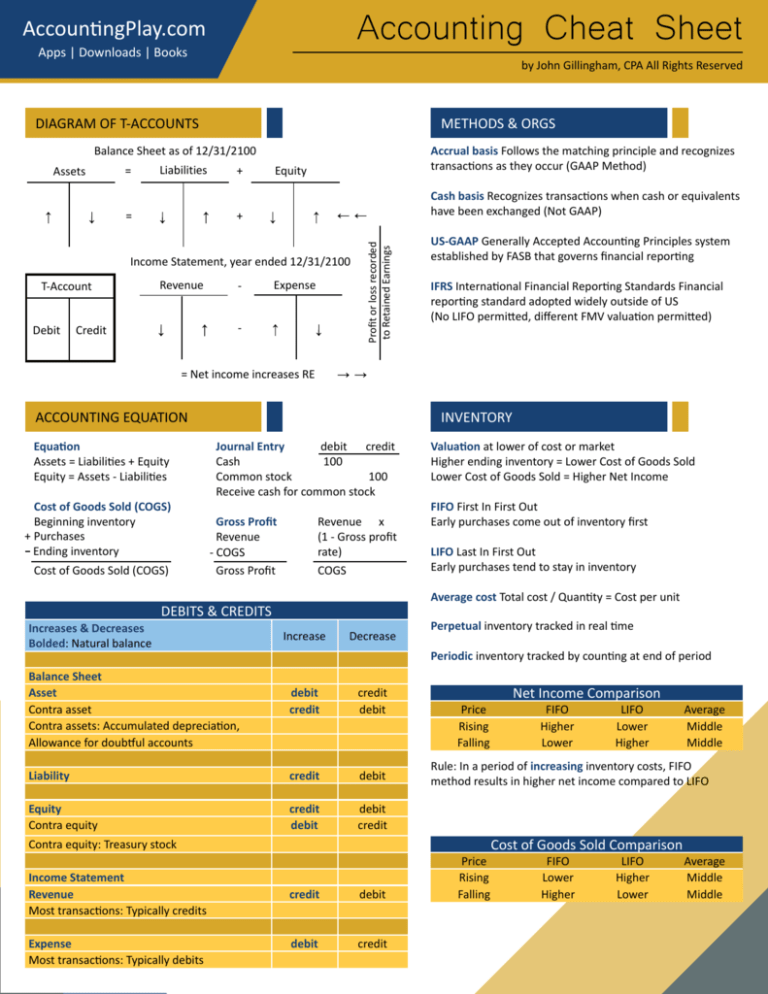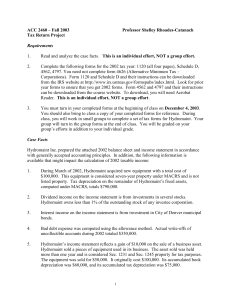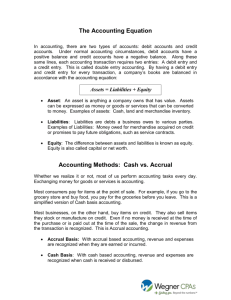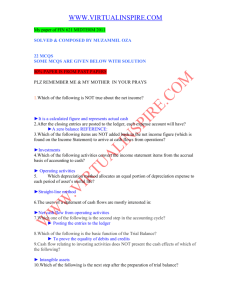
Accounting Cheat Sheet
AccountingPlay.com
Apps | Downloads | Books
by John Gillingham, CPA All Rights Reserved
DIAGRAM OF T-ACCOUNTS
METHODS & ORGS
Balance Sheet as of 12/31/2100
=
Liabilities
=
+
Equity
+
Income Statement, year ended 12/31/2100
T-Account
Debit
Revenue
-
Expense
-
Credit
Profit or loss recorded
to Retained Earnings
Assets
Accrual basis Follows the matching principle and recognizes
transactions as they occur (GAAP Method)
Cash basis Recognizes transactions when cash or equivalents
have been exchanged (Not GAAP)
US-GAAP Generally Accepted Accounting Principles system
established by FASB that governs financial reporting
IFRS International Financial Reporting Standards Financial
reporting standard adopted widely outside of US
(No LIFO permitted, different FMV valuation permitted)
= Net income increases RE
ACCOUNTING EQUATION
Equation
Assets = Liabilities + Equity
Equity = Assets - Liabilities
Cost of Goods Sold (COGS)
Beginning inventory
+ Purchases
Ending inventory
Cost of Goods Sold (COGS)
Increases & Decreases
Bolded: Natural balance
INVENTORY
Journal Entry
debit credit
Cash
100
Common stock
100
Receive cash for common stock
Gross Profit
Revenue x
Revenue
(1 - Gross profit rate)
- COGS
Gross Profit
COGS
DEBITS & CREDITS
Increase
Decrease
debit
credit
credit
debit
Liability
credit
debit
Equity
Contra equity
credit
debit
debit
credit
Balance Sheet
Asset
Contra asset
Contra assets: Accumulated depreciation,
Allowance for doubtful accounts
Valuation at lower of cost or market
Higher ending inventory = Lower Cost of Goods Sold
Lower Cost of Goods Sold = Higher Net Income
FIFO First In First Out
Early purchases come out of inventory first
LIFO Last In First Out
Early purchases tend to stay in inventory
Average cost Total cost / Quantity = Cost per unit
Perpetual inventory tracked in real time
Periodic inventory tracked by counting at end of period
Price
Rising
Falling
Expense
Most transactions: Typically debits
credit
debit
debit
credit
FIFO
Higher
Lower
LIFO
Lower
Higher
Average
Middle
Middle
Rule: In a period of increasing inventory costs, FIFO
method results in higher net income compared to LIFO
Contra equity: Treasury stock
Income Statement
Revenue
Most transactions: Typically credits
Net Income Comparison
Price
Rising
Falling
Cost of Goods Sold Comparison
FIFO
Lower
Higher
LIFO
Higher
Lower
Average
Middle
Middle
Accounting Cheat Sheet
AccountingPlay.com
Apps | Downloads | Books
by John Gillingham, CPA All Rights Reserved
PRINCIPLES, GUIDELINES, ASSUMPTIONS
Comparability
Financial statements must be comparable period to period
Conservatism
Considers all risks | strict rules
Consistency
Same accounting methods year to year
Constraints
Information has a cost/benefit and is material
Cost principle
Keep costs at purchase price or lower (lower of cost or market)
Economic entity
Maintain separate records for each entity
Full disclosure
Provides detailed information in addition to financial statements
Going concern
Assume business is going to and has capability to continue
Matching
Recognize cost the same time as benefit
Materiality
Significance to the overall financial picture
Monetary unit
Currency is used to record transactions and is assumed to be constant
Relevance
Financial reporting has predictive, feedback, and timeliness value
Reliability
Financial reporting is neutral, valid, and verifiable
Revenue recognition
Conditions of how an organization records revenue
Time period
Report financial activity in specific time periods
TEST VOCABULARY
Cost basis
Original cost of investment minus prior accumulated depreciation
Disposition
Sale, scrapping, or removal of an item, typically an asset
Gross | Net
Gross = total number | Net = gross number minus expenses
Goodwill
Purchase price less tangible value of physical assets purchased
Net asset value
Cost basis minus accumulated depreciation (prior total depreciation)
NSF
Non-sufficient funds, typically a returned check
Principal
The amount, typically of a loan
Unrealized gain | loss
Investment that has increased | decreased in value, but not yet sold
Unrealized calculation
Basis minus fair market value (FMV)
INTEREST FORMULAS
Monthly interest
P X (r / 12)
Compound interest
A = P(1 + (r/n))^nt
A = Amount, P = Principal, r = Rate n = compoundings per period, t = number of periods
BANK RECONCILIATION
Balance per bank
+ Deposits in transit
Outstanding checks
+/- Errors, fees, returned items
Balance per books
BUSINESS TYPES
Sole Proprietorship One owner, no liability protection
Partnership Two or more owners, no liability protection
Limited Partnership Two or more owners, liability protection
LLC Limited Liability Company Liability protection, flexible
Corporation Liability protection, double taxation issues
Accounting Cheat Sheet
AccountingPlay.com
Apps | Downloads | Books
by John Gillingham, CPA All Rights Reserved
TECHNICAL INVENTORY AND COSTING
FOB shipping point
Buyer’s books at year end, title passes when goods delivered
FOB destination
Seller’s books at year end, title passes when goods received
Raw materials
Direct costs of materials manufactured such as steel
Overhead costs
Costs typically thought of as expenses that are added to cost of goods
Work in process (WIP)
Goods in the process of being manufactured (assets)
ASSET SALES
Sale of inventory
Increase AR, Increase sales, Decrease inventory, Increase cost of goods sold
Debits and credits
Debit AR, Credit sales, Credit inventory, Debit cost of goods sold
Sell appreciated stock
Increase cash, Increase realized gain, Decrease stock
Debits and credits
Debit cash, Credit realized gain, Credit stock
Sell stock for a loss
Increase cash, Increase realized loss, Decrease stock
Debits and credits
Debit cash, Debit realized loss, Credit stock
Sell depreciated asset, gain
Increase cash, Decrease asset, Decrease accumulated depreciation, Increase gain
Debits and credits
Debit cash, Credit asset, Debit accumulated depreciation, Credit gain on sale
Sell depreciated asset, loss
Increase cash, Decrease asset, Decrease accumulated depreciation, Increase loss
Debits and credits
Debit cash, Credit asset, Debit accumulated depreciation, Debit loss on sale
BONDS
Bonds Financial instrument (agreement) issued by a company to borrow money from investors at a specified term (time) and rate
Issuer Company that is raising the money
Face value Amount that is repaid at the end of term
Stated coupon rate Interest that bond pays investor
Effective interest Rate of interest investor receives if the bond is purchased at a discount or premium
Premium Amount company is paid in excess of face value, often paid when coupon rate is greater than market rate
Premium = Price paid for bond - face value
Discount Amount below the face value paid for a bond often occurs when coupon rate is less than market rate
Discount = Face value - price paid for bond
Depreciation terms
Depreciation methods
Cost
Price paid for asset (may include costs to
install)
Straight line
Rate = (Cost - Salvage value / Useful life)
Book value
Cost - Accumulated depreciation
Declining
Book value x Depreciation rate
Salvage value
Estimated scrap value at the end of asset
life
(Accelerated method)
Rate = Straight line rate x Applicable %
Accelerated methods
Methods resulting in greater depreciation
during earlier years
MACRS / ACRS / DDB
Accelerated depreciation methods
Depreciation
Expense taken on a physical asset over time
Amortization
Expense taken on an intangible asset over
time
Applicable % = 150% for 150 DB and
200% for double declining
Sum-of-years’-digits (Cost - Salvage value) X Applicable
fraction
(Accelerated method)
Applicable fraction = Years of estimated
life remaining / Sum of years digits
Accounting Cheat Sheet
AccountingPlay.com
Apps | Downloads | Books
by John Gillingham, CPA All Rights Reserved
FINANCIAL STATEMENTS
BALANCE SHEET
As of 12/31/2100
Assets
Cash
1,497
Accounts receivable
400
Allowance for doubtful accounts
(90)
Equipment
200
Accumulated depreciation
(40)
Inventory
Total Assets
1,967
Liabilities
Accounts payable
-
Wages payable
300
Note payable
405
Dividends payable
Total Liabilities
705
Equity
Common stock
1,010
Treasury stock
(175)
Retained earnings
427
Total Equity
1,262
Liabilities + Equity
1,967
BALANCE SHEET FEATURES
Balance sheet (statement of financial position) shows the
ending balances of assets, liabilities, and equity at the end of the
accounting period
Mechanics Assets always equal liabilities plus equity, (which forms
the accounting equation)
ASSETS
Current assets To be used within one year of the balance sheet date
or longer, if the operating cycle is greater
Current assets Cash and equivalents, accounts receivable, inventory,
prepaid expenses to be used within a year
Long-term assets Expected benefit greater than one year
Examples: property, plant, equipment, intangible assets (copyrights,
trademarks, goodwill)
Accounts receivable (AR) Cash due from customers who have
purchased goods or received services not yet paid for
Inventory Goods for sale or manufacture, valued under GAAP at
lower of cost or market
Prepaid expense Expenses paid in advance, considered an asset until
used (such as a two year insurance policy)
Accumulated depreciation | amortization The sum of all prior
depreciation | amortization (contra asset) increases with a credit and
offsets the value of depreciable assets reported at cost
LIABILITIES
Current liabilities Obligations due in one year or less
Long-term liabilities Debts owed to creditors, due in more than one
year from the balance sheet date
Accounts payable (AP) Money owed to creditors and vendors
Notes payable Debts owed to banks or other creditors based on
written agreements
Accrued expenses Expenses incurred before the end of the
accounting period, but not yet paid for
Deferred revenue Cash received in advance, but not yet
earned
Long-term bonds payable Money borrowed to finance company
operations, due in more than one year
SHAREHOLDERS’ EQUITY
Common stock Sold to investors for ownership of a
corporation
Preferred stock Investors receive dividends before common
stockholders and usually do not have voting rights
Additional paid-in capital Investment received by corporation,
in excess of par value per share (APIC = Issuance price - Par
value)
Par (stated) value Per share amount on stock certificates, also
referred to as legal capital (no relation to market value)
Retained earnings Sum of all previous profit and losses, less
dividends
Treasury stock Stock repurchased by company
Dividends Corporate profits paid to shareholders from retained
earnings (not an expense)
Accounting Cheat Sheet
AccountingPlay.com
Apps | Downloads | Books
by John Gillingham, CPA All Rights Reserved
INCOME STATEMENT
STATEMENT OF CASH FLOWS FEATURES
Year ended 12/31/2100
Year ended 12/31/2100
Income
Revenue
930
Cash flows from operating activities:
Net income
Cost of goods sold
(10)
Adjustments to reconcile cash used for operations
Gross profit
920
Depreciation and amortization
Expense
40
Changes in operating assets and liabilities:
Bad debt
90
Accounts receivable
Depreciation
40
Inventories
Interest
5
Utilities
50
Wages
300
Total Expense
485
Net Income (Profit)
435
Accounts payable
Allowance for doubtful accounts
(400)
10
90
Accrued expenses
300
Total adjustments
40
435
Net cash used in operating activities
INCOME STATEMENT FEATURES
Income statement (profit and loss) shows the performance
of a business by reporting revenue earned minus expenses
incurred to equal net income or loss (profit or loss)
Mechanics Reports the business activity for a specific period
of time and results in net income or loss, which gets recorded
to retained earnings at the end of the accounting period
REVENUE AND EXPENSE
Revenue recognition Recognize (book into accounting record)
revenue when it is earned and realizable
Expense recognition Expenses are recognized when incurred,
as goods are used and services received
Net income or loss Revenue minus expenses results in net
income or net loss also referred to as profit or loss
Net income increases retained earnings and net loss
decreases retained earnings
STATEMENT OF CASH FLOWS FEATURES
Statement of cash flows Shows the flow of cash in and out of
the business
Mechanics Starts with beginning cash from the prior period
and reconciles to ending cash in the current period showing
the changes
Usefulness Shows actual changes in cash on a cash basis,
instead of the accrual basis which does not necessarily reflect
the flow of cash
Indirect method of preparation uses the changes in accrual
basis accounts
Direct method of preparation (uncommon) presents specific
cash flows such as cash received from customers and paid to
suppliers
475
Cash flows from investing activities:
Purchase of property and equipment
(200)
Net cash used in investing activities
(200)
Cash flows from financing activities:
Proceeds from notes payable
500
Proceeds from issuance of common stock
1,000
Purchase of treasury stock
(175)
Principal on loan payment
(95)
Dividend paid
(8)
Net cash provided by financing activities
1,222
Net increase in cash and equivalents
1,497
Cash and cash equivalents, beginning
Cash and cash equivalents, ending
1,497
Accounting Cheat Sheet
AccountingPlay.com
Apps | Downloads | Books
by John Gillingham, CPA All Rights Reserved
STATEMENT OF OWNERS’ EQUITY FEATURES
Statement of owners' equity shows sources of capital (business funding), additional paid in capital and common stock breakdown, changes
in retained earnings, and treasury stock (stock repurchased)
Mechanics The statement starts with beginning balances and reconciles to ending period balance
STATEMENT OF OWNERS' EQUITY
As of 12/31/2100
Common stock
Retained earnings
Treasury stock
Total
Balance
December 31, 2099
10
435
Net income for 2100
Common stock issued
10
435
1,000
1,000
(175)
Treasury stock
(8)
Dividends
(175)
(8)
Balance
December 31, 2100
1,010
427
(175)
1,262
Accounting Cheat Sheet
AccountingPlay.com
Apps | Downloads | Books
by John Gillingham, CPA All Rights Reserved
COMMON JOURNAL ENTRIES
Year ended 12/31/2014
debit
Receive 1,000 investment for common stock
Cash
Common stock
Receive $500 loan
Cash
Note payable
Purchase $200 equipment
Equipment
Cash
1,000
Make $30 cash sale, 1 unit, cost $10
Cash
Revenue
Cost of goods sold
Inventory
500
Repurchase $175 of company stock
Treasury account
Cash
credit
1,000
500
200
200
Collect $500 credit sale
Cash
Accounts receivable
Establish $90 Allowance for doubtful accounts
Bad debt expense
Allowance for doubtful
Record utilities expense $50 after receiving bill
Utilities expense
Accounts payable
Pay utility company $50 in cash for prior bills
Accounts payable
Cash
Accrue $300 in wage expense
Wage expense
Wages payable
Make $100 payment on note payable with cash:
$5 interest $95 principal
Interest expense
Note payable
Cash
Record $40 of depreciation expense
Depreciation
expense
Accumulated depreciation
10
10
175
175
930
Revenue
Bad debt
Cost of goods sold
Depreciation
Interest
Utilities
Wages
900
900
Revenue
30
Close out income statement accounts to income
summary
Make $900 credit sale for services performed
Accounts
receivable
30
Income summary
435
Close income summary to retained earnings
Income summary
Retained earnings
435
90
10
40
5
50
300
500
500
435
90
90
Declare $8 dividend
Retained earnings
8
8
Dividends payable
50
50
Pay $8 dividend
Dividends payable
8
Cash
50
50
300
300
US $7.99
5
95
100
Visit Us At
www.AccountingPlay.com
40
40
8








